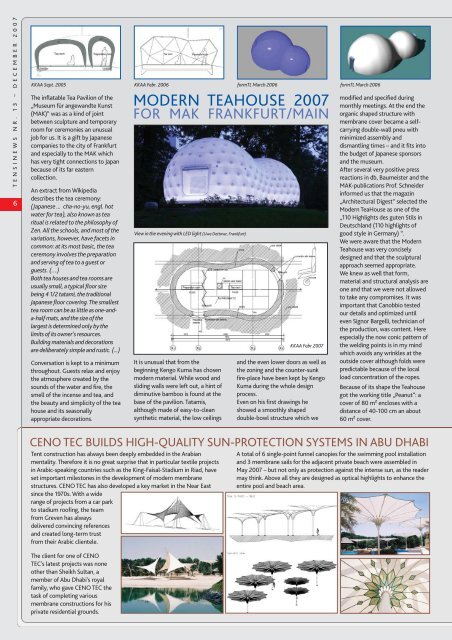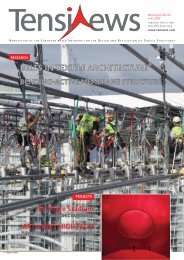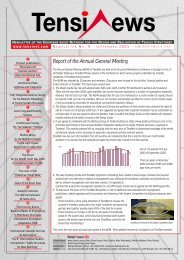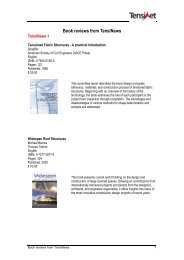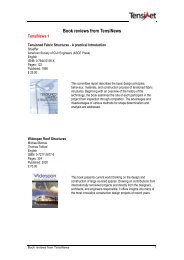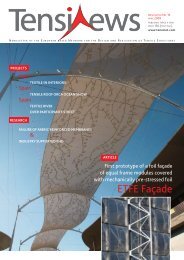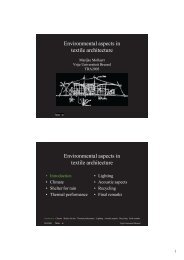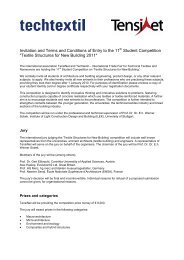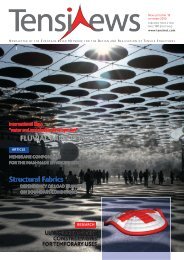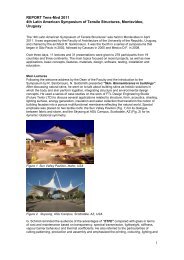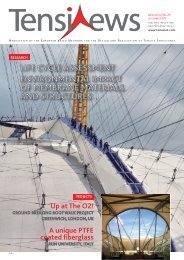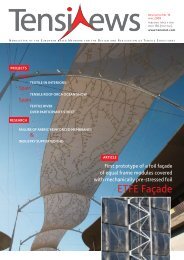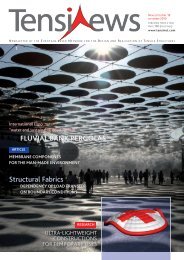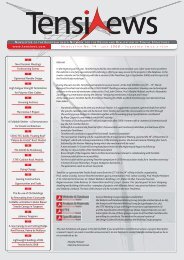TensiNews 13 - TensiNet
TensiNews 13 - TensiNet
TensiNews 13 - TensiNet
Create successful ePaper yourself
Turn your PDF publications into a flip-book with our unique Google optimized e-Paper software.
TENSINEWS NR. <strong>13</strong> – DECEMBER 2007<br />
6<br />
KKAA Sept. 2005 KKAA Febr. 2006 formTL March 2006 formTL March 2006<br />
The inflatable Tea Pavilion of the<br />
„Museum für angewandte Kunst<br />
(MAK)“ was as a kind of joint<br />
between sculpture and temporary<br />
room for ceremonies an unusual<br />
job for us. It is a gift by Japanese<br />
companies to the city of Frankfurt<br />
and especially to the MAK which<br />
has very tight connections to Japan<br />
because of its far eastern<br />
collection.<br />
An extract from Wikipedia<br />
describes the tea ceremony:<br />
(Japanese ... cha-no-yu, engl. hot<br />
water for tea), also known as tea<br />
ritual is related to the philosophy of<br />
Zen. All the schools, and most of the<br />
variations, however, have facets in<br />
common: at its most basic, the tea<br />
ceremony involves the preparation<br />
and serving of tea to a guest or<br />
guests. (…)<br />
Both tea houses and tea rooms are<br />
usually small, a typical floor size<br />
being 4 1/2 tatami, the traditional<br />
Japanese floor covering. The smallest<br />
tea room can be as little as one-anda-half<br />
mats, and the size of the<br />
largest is determined only by the<br />
limits of its owner's resources.<br />
Building materials and decorations<br />
are deliberately simple and rustic. (...)<br />
Conversation is kept to a minimum<br />
throughout. Guests relax and enjoy<br />
the atmosphere created by the<br />
sounds of the water and fire, the<br />
smell of the incense and tea, and<br />
the beauty and simplicity of the tea<br />
house and its seasonally<br />
appropriate decorations.<br />
View in the evening with LED light (Uwe Dettmar, Frankfurt)<br />
It is unusual that from the<br />
beginning Kengo Kuma has chosen<br />
modern material. While wood and<br />
sliding walls were left out, a hint of<br />
diminutive bamboo is found at the<br />
base of the pavilion. Tatamis,<br />
although made of easy-to-clean<br />
synthetic material, the low ceilings<br />
Tent construction has always been deeply embedded in the Arabian<br />
mentality. Therefore it is no great surprise that in particular textile projects<br />
in Arabic-speaking countries such as the King-Faisal-Stadium in Riad, have<br />
set important milestones in the development of modern membrane<br />
structures. CENO TEC has also developed a key market in the Near East<br />
since the 1970s. With a wide<br />
range of projects from a car park<br />
to stadium roofing, the team<br />
from Greven has always<br />
delivered convincing references<br />
and created long-term trust<br />
from their Arabic clientele.<br />
The client for one of CENO<br />
TEC's latest projects was none<br />
other than Sheikh Sultan, a<br />
member of Abu Dhabi's royal<br />
family, who gave CENO TEC the<br />
task of completing various<br />
membrane constructions for his<br />
private residential grounds.<br />
MODERN TEAHOUSE 2007<br />
FOR MAK FRANKFURT/MAIN<br />
KKAA Febr.2007<br />
and the even lower doors as well as<br />
the zoning and the counter-sunk<br />
fire-place have been kept by Kengo<br />
Kuma during the whole design<br />
process.<br />
Even on his first drawings he<br />
showed a smoothly shaped<br />
double-bowl structure which we<br />
modified and specified during<br />
monthly meetings. At the end the<br />
organic shaped structure with<br />
membrane cover became a selfcarrying<br />
double-wall pneu with<br />
minimized assembly and<br />
dismantling times – and it fits into<br />
the budget of Japanese sponsors<br />
and the museum.<br />
After several very positive press<br />
reactions in db, Baumeister and the<br />
MAK-publications Prof. Schneider<br />
informed us that the magazin<br />
„Architectural Digest“ selected the<br />
Modern TeaHouse as one of the<br />
„110 Highlights des guten Stils in<br />
Deutschland (110 highlights of<br />
good style in Germany) “.<br />
We were aware that the Modern<br />
Teahouse was very concisely<br />
designed and that the sculptural<br />
approach seemed appropriate.<br />
We knew as well that form,<br />
material and structural analysis are<br />
one and that we were not allowed<br />
to take any compromises. It was<br />
important that Canobbio tested<br />
our details and optimized until<br />
even Signor Bargelli, technician of<br />
the production, was content. Here<br />
especially the now conic pattern of<br />
the welding points is in my mind<br />
which avoids any wrinkles at the<br />
outside cover although folds were<br />
predictable because of the local<br />
load concentration of the ropes.<br />
Because of its shape the Teahouse<br />
got the working title „Peanut“: a<br />
cover of 80 m² encloses with a<br />
distance of 40-100 cm an about<br />
60 m² cover.<br />
CENO TEC BUILDS HIGH-QUALITY SUN-PROTECTION SYSTEMS IN ABU DHABI<br />
A total of 6 single-point funnel canopies for the swimming pool installation<br />
and 3 membrane sails for the adjacent private beach were assembled in<br />
May 2007 – but not only as protection against the intense sun, as the reader<br />
may think. Above all they are designed as optical highlights to enhance the<br />
entire pool and beach area.


